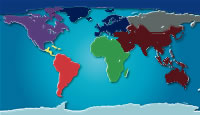Air

Despite recent improvements, poor air quality is still a major concern affecting public health worldwide. In developing countries, air pollution continues to worsen in most large cities, a situation driven by population growth, industrialization and increased vehicle use. Worldwide, the World Health Organization (WHO) estimates that as many as 1.4 billion urban residents breathe air that does not meet the WHO air quality guidelines ![]() . According to WHO, poor air quality leads to 800,000 premature deaths a year.
. According to WHO, poor air quality leads to 800,000 premature deaths a year.
As the U.S. federal agency responsible for the management of national air quality programs, the EPA has a long history of working with partners in the United States and abroad to address a range of air quality concerns. It is increasingly difficult for EPA to achieve its domestic environmental objectives without international environmental collaboration. Reducing international sources of air pollutants is a top EPA priority.
Featured Program |
|
Program |
Partnership for Clean Fuels and Vehicles |
Result |
All countries of sub-Saharan Africa eliminated lead in gasoline at the end of 2005, reducing lead exposure for over 750 million people. |
The EPA is working with other nations and through multilateral organizations to reduce air pollution at its source. For example,
- Cooperative programs with Mexico and Canada are especially important since they help control much of the pollution that degrades environmental quality throughout North America.
- EPA's work in Central America, China, India, and Africa is improving our understanding of air pollution's sources, transport, and effects.
- EPA's cooperation with the Pan-American Health Organization
 (PAHO), for example, led to an assessment of the health effects of ambient air pollution in Latin America and the Caribbean, which in turn prompted follow-up health work in the region.
(PAHO), for example, led to an assessment of the health effects of ambient air pollution in Latin America and the Caribbean, which in turn prompted follow-up health work in the region. - Similarly, through mechanisms such as the Asia-Pacific Partnership on Clean Development and Climate
 , we can work to mitigate the harmful effects of climate change.
, we can work to mitigate the harmful effects of climate change. - More than 2 billion people in the developing world burn traditional biomass fuels indoors for cooking and heating. Internationally, EPA is a leading partner in The Partnership for Clean Indoor Air, launched at the World Summit on Sustainable Development in Johannesburg.
- Motor vehicles are a large source of urban air pollution in most urban areas. EPA's Information on Transportation and Air Quality outlines a variety of information resources, tools, and technologies to reduce air pollution from vehicles in the U.S. Internationally, EPA is a leading partner in the United Nations Environment Programme Partnership for Clean Fuels and Vehicles
 , which was launched at the World Summit on Sustainable Development in 2002.
, which was launched at the World Summit on Sustainable Development in 2002. - While countries’ agreed-upon pollution levels vary, the overall system for planning, assessing, characterizing, mitigating and implementing control strategies is similar. The Air Quality Management Manual Online Portal is a comprehensive website for international air quality management professionals and other interested parties, describing the different components of an air quality management system.
- More International Air Partnerships
![[logo] US EPA](https://webarchive.library.unt.edu/eot2008/20090510053626im_/http://www.epa.gov/epafiles/images/logo_epaseal.gif)
